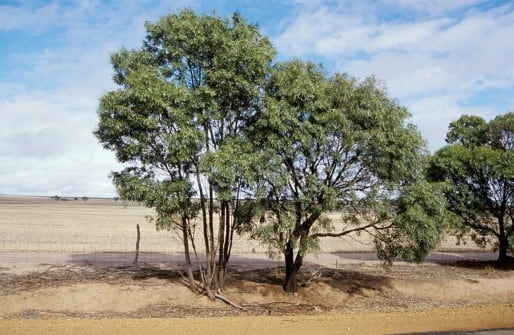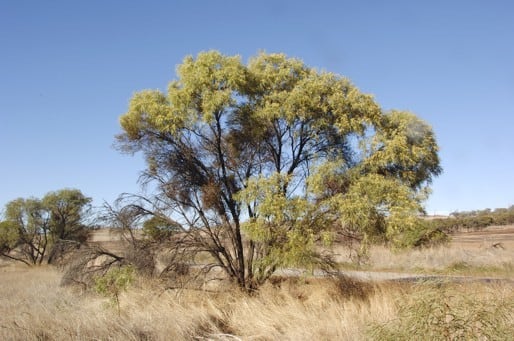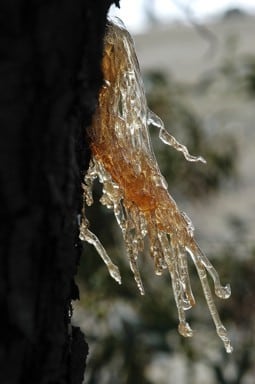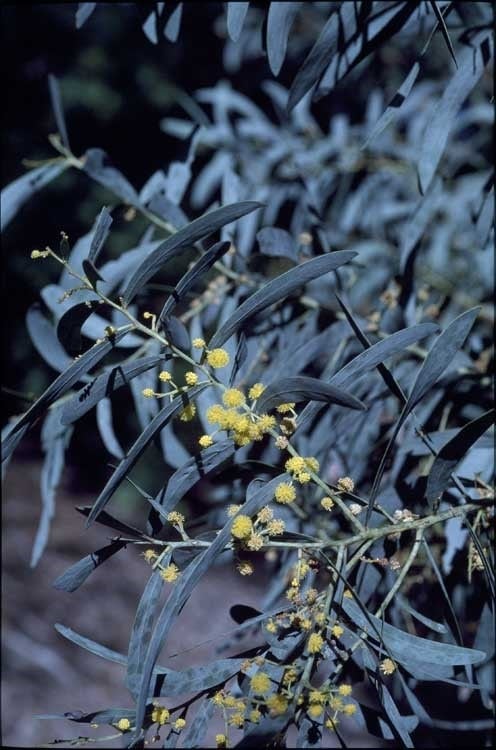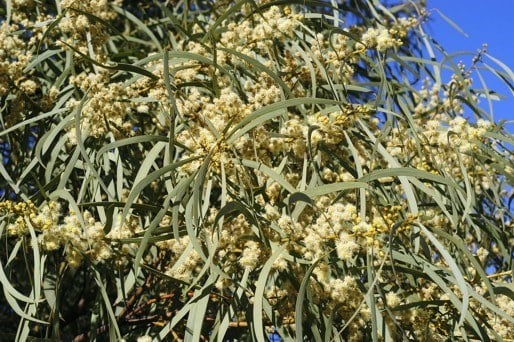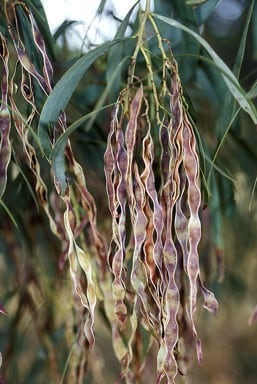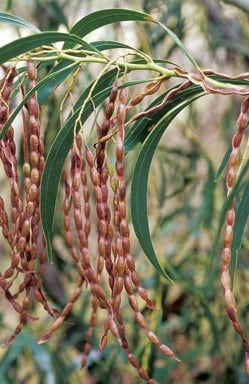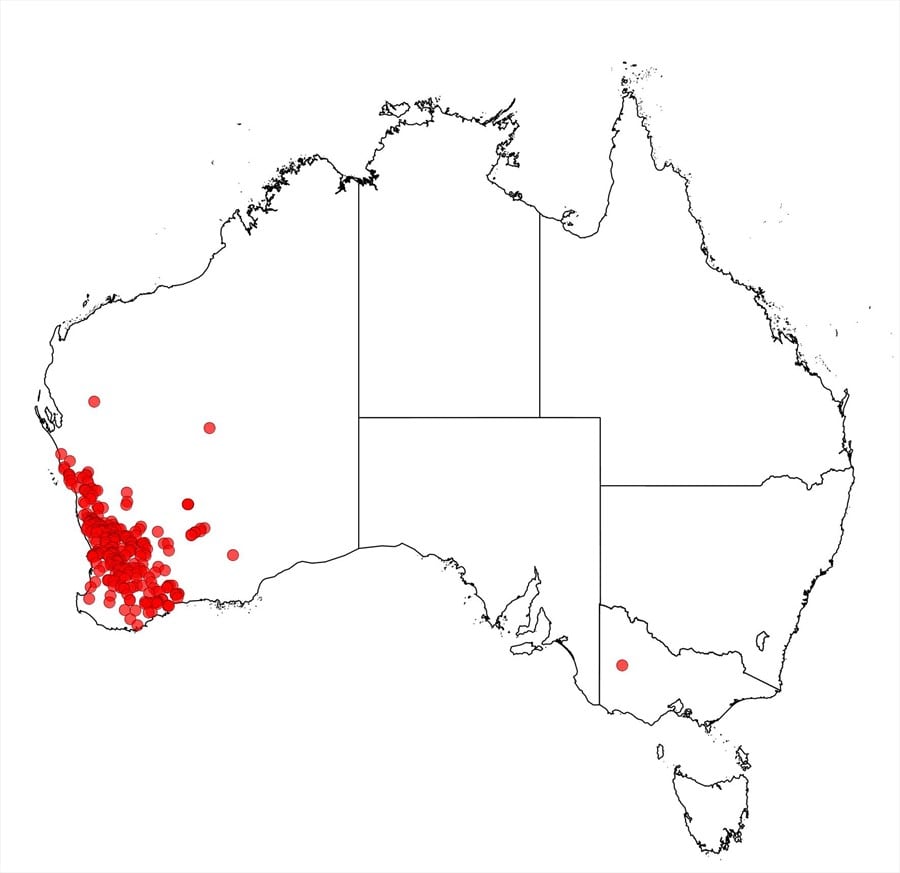Acacia microbotrya Benth.
WATTLE
Acacias of Australia
Common Name
Manna Wattle
Family
Fabaceae
Distribution
Occurs in the central and southern wheatbelt region of south-western W.A. from near Dandaragan E to near Merredin and S to the vicinity of Kojonup and Ravensthorpe. In recent years this species has been used for roadside regeneration in areas outside its natural range.
Description
Sturdy shrub or tree 3–8 (–10) m high, with 1–3 (–4) main trunks, crowns bushy, often suckering. Bark light- or dark-grey to black, smooth to rough and longitudinally fissured. Branchlets glabrous. Phyllodes patent to pendulous, narrowly elliptic to oblanceolate, shallowly to obviously falcately recurved, (7–) 8–15 (–18) cm long, (5–) 8–18 (–25) mm wide, acute to acuminate, thinly coriaceous, grey-green to sub-glaucous or glaucous but commonly aging green glabrous, 1‑nerved per face, obscurely penninerved; gland not prominent, 2–30 (–40) mm above pulvinus. Inflorescences racemose; raceme axes mostly 1–6 (–8) cm long, sparsely to densely appressed-puberulous with yellow or white hairs that are often absent at base of axes; peduncles 2–6 mm long, with indumentum as on raceme axes; heads showy, globular, 3–6 mm diam. at anthesis (dry), 20–35 (–40)-flowered, cream to pale yellow or bright lemon yellow; bracteole laminae golden-fimbriolate. Flowers 5-merous; sepals united. Pods moniliform to submoniliform, 9–20 (–24) cm long, (5–) 6–9 mm wide, thinly coriaceous, reddish brown to blackish (dry), glabrous. Seeds oblong to elliptic, 5–8 mm long, 3–5 (–6) mm wide, subshiny, dark brown to black, smooth or minutely pitted, ½ or more commonly wholly encircled by a light brown to dark red-brown, slender funicle; aril clavate.
Phenology
Flowers Apr.–early July with the main flush from early May–late June.
Habitat
Grows in a range of habitats but is commonly found on clay-loam or sandy loam flats, often near watercourses; the Dandaragan variant favours sandy soil. Often locally common and often found along degraded road verges.
Specimens
W.A.: Fitzgerald R., c. 112.7 km ESE of Ongerup, R.Coveny 3260 et al. (NSW, PERTH); 20.9 km S of Konnongorring between Goomalling and Wongan Hills, B.R.Maslin 1631 (NSW, PERTH); 16.5 km E of Dandaragan on rd to Moora, B.R.Maslin 8206F (PERTH); in glareosis illustribus sylvae inter praedia rustica Dom. Barker et Lennard [between York and Guilford], L.Preiss 923 (LUND, MEL).
Notes
The concept of A. microbotyra by B.R.Maslin, Fl. Australia 11A: 284 (2001), has changed with the removal of the short-phyllode entity from N of about Moora as A. daphnifolia.
This species, together with 43 relatives Australia-wide, was defined by B.R.Maslin, Nuytsia 10: 186 (1995) as comprising the informal ‘Acacia microbotrya group’. A number of taxa have subsequently been added to the group, namely, A. euthycarpa, A. daphnifolia, A. provincialis, A. splendens, A. spooneri, Acacia sp. Kalannie (B.R.Maslin 7571), Acacia sp. Kalannie (B.R.Maslin 7706), Acacia sp. Merredin (B.R. Maslin 586), Acacia sp. Small Red-leaved Wattle (J.B.Williams 95033), Acacia sp. Wubin (B.R. Maslin 4131), A. toondulya and A. uncifolia. Among other characters, the members of the group are normally recognised by their filiform funicle which is usually red or red-brown and which partially or completely encircles the seed in a single or double fold. Acacia latisepala, which is normally referred to sect. Botrycephalae, has the same sort of funicle. Some members of the group, particularly A. chrysella, A. brumalis, A. chamaeleon and A. microbotrya from W.A., are extremely variable and further studies are needed to elucidate the complex variation patterns and clarify the relationships between these species. It is likely that future work will result in the recognition of additional species within this species-complex.
A variant characterized by its tall stature, distinctly acuminate, green, slightly shiny phyllodes and slightly narrower than normal pods and seed that occurs W and NW of Moora was described by B.R.Maslin and M.W.McDonald, loc. cit., as A. bartleana (ms) but it is now not considered worthy of formal recognition. This entity has more potential for development as a crop plant for high volume wood production than does typical A. microbotrya, see B.R.Maslin and M.W.McDonald, AcaciaSearch: Evaluation of Acacia as a woody crop option for southern Australia, RIRDC Publication No. 03/017: 50–53 and 136–140 (2004), for discussion.
Acacia microbotrya is especially closely related to A. daphnifolia, A. amblyophylla and A. jennerae and is superficially similar to A. galeata. It is a hardy, drought- and frost-tolerant, fast-growing species with a life span of about 20–30 years.
FOA Reference
Data derived from Flora of Australia Volumes 11A (2001), 11B (2001) and 12 (1998), products of ABRS, ©Commonwealth of Australia
Author
B.R.Maslin
Revised by B.R.Maslin
This identification key and fact sheets are available as a mobile application:
URL: https://apps.lucidcentral.org/wattle/
© Copyright 2018. All rights reserved.
